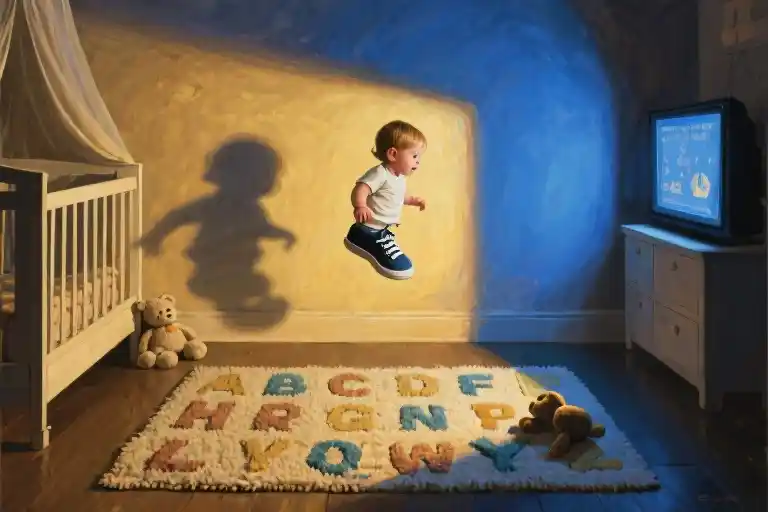At 14, standing in front of the dressing room mirror in a suburban mall, I first noticed the buzzing. It wasn’t the fluorescent lights humming overhead – this sound lived permanently behind my temples. The kind of white noise you learn to ignore until it suddenly roars. That day, the reflection staring back at me wasn’t the girl who’d aced her algebra test or won the poetry contest. It was suddenly just a body, all wrong proportions and misplaced curves under the unforgiving glare of a Limited Too crop top.
The buzzing never really stopped these past twenty-five years. Some days it fades to background static when I’m engrossed in work or laughing with friends. Other moments – stepping on a scale at the doctor’s office, catching my profile in a department store mirror – it swells to deafening levels. I know better, intellectually. I’ve read all the feminist theory about patriarchal beauty standards. I can recite the statistics about photo retouching and the $500 billion beauty industry preying on women’s insecurities. But knowledge doesn’t automatically rewire the gut reaction when my jeans feel snug after the holidays.
Motherhood brought unexpected relief. Not because pregnancy transformed my relationship with my body – quite the opposite. The stretch marks and shifted waistline became my armor. ‘I’ve had three kids,’ I’d shrug internally when noticing my softening midsection, as if creating humans granted me diplomatic immunity from beauty standards. The weight always returned to my pre-pregnancy numbers, but something fundamental had changed. I’d discovered the ultimate societal excuse card: reproductive sacrifice.
For years, this quiet bargain worked. Until the afternoon I overheard my then twelve-year-old daughter muttering to her reflection: ‘Ugh, my thighs look huge in these.’ The buzzing in my head spiked to emergency-alarm levels. Not because she’d noticed her changing body – that’s developmentally normal – but because of what happened next. When I automatically responded with the script I’d rehearsed (‘Honey, you’re beautiful at any size!’), she turned with devastating clarity and asked, ‘Then why don’t you believe that about yourself?’
The Illusion of Comfort: Motherhood as a Body Image Shield
The scale said I was back to my pre-pregnancy weight six months after my second child, but the mirror told a different story. My reflection seemed permanently altered – not just by stretch marks or looser skin, but by this new cultural permission slip I’d unconsciously granted myself. “She’s a mom now” became society’s whispered justification for my body’s deviations from the glossy magazine standards I’d internalized since adolescence.
There was something almost comforting about this unspoken agreement. The same culture that had scrutinized every inch of my teenage body now offered me this strange maternity pass. I remember standing in a dressing room, staring at my changed silhouette, and thinking well, at least now I have an excuse. It felt like cheating the system – like I’d discovered a loophole in the beauty contract we all supposedly signed at puberty.
But this psychological bargaining came with hidden costs I wouldn’t recognize for years. Every time I shrugged off a critical thought with “I’ve had two kids,” I wasn’t rejecting unrealistic standards – I was reinforcing them. My supposed liberation was actually a subtle form of surrender, accepting that these beauty norms were valid for everyone except those with what society deemed “good enough” reasons to opt out.
The postpartum body rebound became my shield against self-criticism, but like any shield, it only worked when held at a very specific angle. It couldn’t protect me from overhearing my daughter ask why her friend’s mom “let herself go,” or from noticing how quickly the cultural grace period expired once kids reached school age. That temporary maternity armor started feeling less like protection and more like another set of measurements I might fail.
What began as a private mental truce revealed itself to be what it always was – not freedom from beauty standards, but a more sophisticated form of compliance. By accepting motherhood as my justification rather than questioning why justification was needed at all, I’d become complicit in maintaining the very system I thought I’d escaped. The realization hit hardest when I caught myself explaining away a friend’s weight gain with “well, she’s raised three kids” – hearing how my own logic sounded when applied to someone else.
This chapter of my body image journey wasn’t about making peace with my appearance; it was about learning to recognize when I was bargaining with unreasonable demands instead of rejecting them entirely. The cultural narrative that allowed me temporary respite would eventually show its limitations when facing a new generation less willing to accept even conditional self-acceptance.
Mirror Reflections: When Your Child Repeats Your Insecurities
The moment crystallized during a routine school pickup. My thirteen-year-old emerged from the locker room with that particular slump in her shoulders I recognized instantly – the same defeated posture I’d practiced for years after swim class. ‘They were all comparing thigh gaps,’ she muttered into her backpack straps, and suddenly I wasn’t holding car keys anymore but a time machine steering wheel, hurled back to 1996 when Spice Girls posters dictated my idea of acceptable proportions.
What shocked me wasn’t the persistence of body shaming across generations (though that stung), but how my carefully constructed coping mechanisms crumbled when reflected through her experience. All those years telling myself ‘motherhood exempts me from beauty standards’ felt suddenly exposed as what they truly were – not liberation, but surrender with better PR. When my daughter looked up and asked, ‘But you don’t like your body either, right?’ it wasn’t accusation in her voice. It was the terrifying sound of a cultural script being handed down intact.
We dissected the conversation later over melted ice cream, a conscious choice to associate these hard talks with small pleasures. ‘Why do we care what random people think?’ she wondered aloud, and there it was – the question I’d avoided asking myself for twenty years. In that sticky booth, I began mapping how body image anxieties transmit between generations not through grand pronouncements, but through microscopic daily interactions: The way I’d turn sideways checking mirrors. My automatic ‘I look terrible’ when someone complimented an outfit. The subtle relief when pregnancy provided socially acceptable cover for weight fluctuations.
Breaking this cycle required confronting an uncomfortable truth: My ‘harmless’ personal compromises had been maintenance work on a system I claimed to reject. Every time I used motherhood as justification for not meeting beauty standards (‘I’ve had three kids, what do you expect?’), I’d reinforced their validity. The standards remained the judge; I’d merely pleaded temporary insanity.
What surprised me most was how quickly my daughter spotted the contradictions. Teens today navigate body image issues with a sharper critical lens than my generation ever managed – perhaps because they’ve never known a world without body positivity hashtags or influencer call-out culture. Where I’d perfected the art of quiet self-loathing, she demanded explanations: ‘Who decided thin equals healthy?’ ‘Why do women’s magazines always talk about “getting your body back” after babies?’ Her questions became crowbars prying open mental doors I’d sealed shut with resignation.
This chapter of our story holds the messiest, most hopeful moments. Like when we conducted an impromptu audit of her Instagram feed, calculating what percentage of ‘fitspo’ posts came from accounts selling workout plans or detox teas. Or the rainy Sunday we spent rewriting fashion magazine headlines in Sharpie (‘Try this: Wear whatever brings you joy’). Small acts of rebellion that felt silly until they didn’t, until we’d created enough cognitive dissonance to disrupt the automatic acceptance of received wisdom.
The buzzing hasn’t disappeared – not for me, not for her. But we’re learning to distinguish between the noise that’s ours and the noise we’ve been handed. Some days that means calling out diet culture during commercial breaks. Others, it’s as simple as her rolling her eyes when I criticize my reflection and saying, ‘Mom. We’ve talked about this.’ The beautiful irony? In helping her develop immunity to toxic standards, I’m finally building my own.
Weaponizing Curiosity: The Questions That Unravel Standards
The moment my daughter came home from school clutching her stomach, claiming she ‘felt fat’ in her gym shorts, something shifted permanently in our kitchen. Not just because history was repeating itself (though the echo of my own teenage voice saying those exact words made me nauseous), but because I finally understood: our polite justifications for not measuring up were actually keeping the whole toxic system running.
Corporate Profit Dissection Exercise
We started with a simple Google search that afternoon: ‘how much does the beauty industry make from women’s insecurities?’ The $532 billion global market figure appeared, followed by a list of companies that spent more on making us feel inadequate than on actual product research. My son, then twelve, pointed at the screen: ‘So when you hate your thighs, someone gets a bonus?’ His crude math lesson stuck – every time we criticize our post-baby bodies as ‘forgiven imperfections,’ we’re essentially thanking corporations for permission to exist.
Here’s the exercise that changed our family dinners:
- Identify the transaction: Pick any beauty standard (smooth skin, thigh gaps, perky breasts) and trace its profitability
- Follow the money: Research which companies benefit most from this specific insecurity (Hint: It’s never small businesses)
- Calculate the cost: Not just financial – tally hours spent worrying, money spent ‘fixing,’ opportunities missed
Family Media Literacy Challenge
We took it further by collecting magazines and digitally altering ads together. My daughter enjoyed rewriting Victoria’s Secret captions: ‘This model probably skipped lunch to look this hungry’ became ‘Real wings would require actual protein intake.’ What began as sarcasm evolved into sharper media analysis – she now automatically deconstructs Instagram filters by asking:
- Who paid for this image to exist?
- What are they trying to make me buy or believe?
- How would this look without professional lighting/editing?
The unexpected benefit? My kids developed immunity to influencer culture while I finally stopped mentally airbrushing myself in mirrors. Our shared vocabulary includes terms like ‘fear-based marketing’ and ‘manufactured dissatisfaction,’ which we spot like Waldo in every commercial break.
Body Sovereignty as Daily Practice
We instituted what my son dubbed ‘rebellion rituals’:
- Grocery store resistance: Reading nutritional labels aloud in silly voices to disrupt diet culture’s seriousness
- Closet reclamation: Removing any clothing that required ‘body maintenance’ to wear comfortably
- Compliment audits: Converting ‘You look great, have you lost weight?’ into ‘You seem energized today’
The most transformative tool emerged accidentally when my daughter asked why I always said ‘I need to exercise’ instead of ‘I want to move.’ That distinction – between punishment and pleasure – became our family’s litmus test. Now when we discuss bodies, we ask:
- Is this choice coming from fear or freedom?
- Who originally defined this as a problem?
- What would happen if we simply ignored this ‘rule’?
What began as protective parenting became mutual liberation. My children’s unfiltered questions (‘But why do you care if strangers think you’re pretty?’) forced me to confront how much mental real estate I’d surrendered to arbitrary standards. Together, we’re learning that curiosity dismantles shame faster than any affirmation – because once you see the strings, the puppet stops dancing.
The Buzzing and The Dance
The buzzing hasn’t disappeared. That constant hum of body awareness still lives somewhere between my temples, a familiar presence since I first struggled to zip up those Guess jeans in 1996. But something fundamental has changed in how I relate to that noise. Where it once dictated my movements – sucking in before mirrors, avoiding group photos, measuring worth by the gap between my thighs – now we’ve reached an uneasy truce. I’ve learned to dance to its rhythm rather than let it conduct my life.
This shift didn’t come from self-help books or therapy breakthroughs (though both helped). It came from watching my daughter scrutinize her swimsuit reflection with the same critical tilt of the head I’d perfected decades earlier. That moment shattered the fragile peace I’d brokered with my body through motherhood – the unspoken cultural contract that says ‘after babies, you’re allowed to opt out of beauty standards.’
Three conversation starters changed everything. Not polished speeches or therapeutic interventions, just honest questions we began asking at dinner:
- Who profits when you dislike your body? (Tracing the $532 billion beauty industry’s fingerprints on our insecurities)
- What can your body do that amazes you today? (Shifting focus from aesthetics to capability)
- If no one else’s opinion mattered, how would you treat your body? (Revealing internalized voices)
These questions became our secret weapons against the buzzing. My son took them further than I imagined possible, creating protest signs for a school body positivity rally that read ‘MY BMI IS NONE OF YOUR BUSINESS’ with pie charts showing how weight standards have changed arbitrarily through history. His teenage rebellion against diet culture shamed my decades of quiet compliance.
There’s liberation in realizing our children might complete journeys we only began. The dance continues – some days clumsy, some days fluid – but now at least we’re choosing the music. That photo of my son holding his sign at the rally? It’s my screensaver, a daily reminder that the buzzing doesn’t have to stop us from moving.
Tonight’s conversation starters (tear along the dotted line):
- When did you first realize beauty standards are made up?
- What’s one thing your body did for you today that you’re grateful for?
- If you designed the perfect world, how would people think about bodies?





